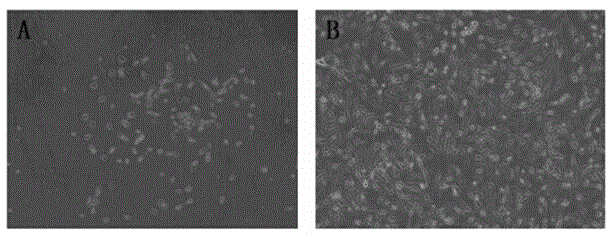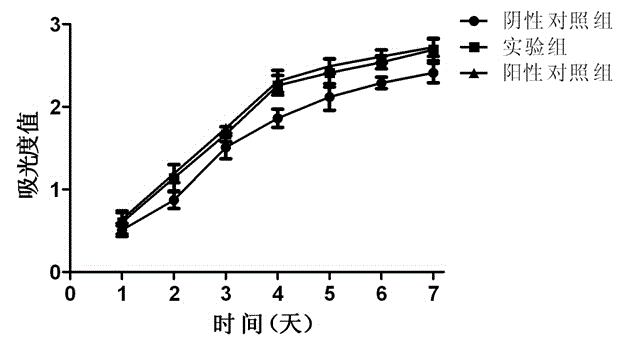Endothelial progenitor cell (EPC) culture method
An endothelial progenitor cell and culture method technology, applied in the field of biological cell culture, can solve the problems of high EPC culture cost, difficulty in EPC separation and culture, etc., and achieve the effects of reducing culture cost, easy adherence, and fast growth rate.
- Summary
- Abstract
- Description
- Claims
- Application Information
AI Technical Summary
Problems solved by technology
Method used
Image
Examples
preparation example Construction
[0031] Step a. Preparation and storage of type I rat tail collagen;
[0032] Step b. type I rat tail collagen coating cell culture flask;
[0033] Step c. Separation of human peripheral blood mononuclear cells;
[0034] Step d. inoculate the above-mentioned isolated mononuclear cells in the cell culture flasks coated with type I rat tail collagen, add negative control group and positive control group to the experiment, and add DMEM medium in the three groups of culture flasks at 37 °C, 5%CO 2 , cultivated in an incubator with 95% humidity;
[0035] Step e. digestion and passage of EPC;
[0036] Step f. The cell flow cytometry analysis detection of EPC;
[0037] Step g. the immunofluorescence detection of EPC;
[0038] Step h. cell proliferation experiment, observe the proliferation ability of EPC;
[0039] Step i. Single cell cloning experiment to observe the proliferation and self-renewal ability of EPC;
[0040] Step j. FITC-UEA-1 extracellular adsorption and endocyto...
Embodiment
[0048] The preparation, purification, detection and coating of cell culture flasks of type I rat tail collagen include the following steps:
[0049] a) Wash the tail of the rat, soak it in 75% alcohol for 15 minutes, cut off the tail, remove the fur and cut it into small pieces, pull out the silver tail tendon, cut the tail tendon and soak it in normal saline, Add the tendon to 0.1% acetic acid at a ratio of 50ml, shake it to disperse the tendon in the acetic acid solution, and place it at 4°C for 72 hours;
[0050] b) Transfer the above-mentioned fully dissolved liquid into a sterile centrifuge tube, and centrifuge. Centrifugation conditions: 4°C, 4000rpm, 10min;
[0051] c) Take the above supernatant, aliquot and store at 4°C for future use;
[0052] d) using the Kjeldahl method to detect the content of collagen in the above supernatant;
[0053] e) Use the prepared type I rat tail collagen to coat the cell culture flask, and the coating concentration is 6-10ug / cm 2 . Ad...
PUM
 Login to View More
Login to View More Abstract
Description
Claims
Application Information
 Login to View More
Login to View More - R&D
- Intellectual Property
- Life Sciences
- Materials
- Tech Scout
- Unparalleled Data Quality
- Higher Quality Content
- 60% Fewer Hallucinations
Browse by: Latest US Patents, China's latest patents, Technical Efficacy Thesaurus, Application Domain, Technology Topic, Popular Technical Reports.
© 2025 PatSnap. All rights reserved.Legal|Privacy policy|Modern Slavery Act Transparency Statement|Sitemap|About US| Contact US: help@patsnap.com



